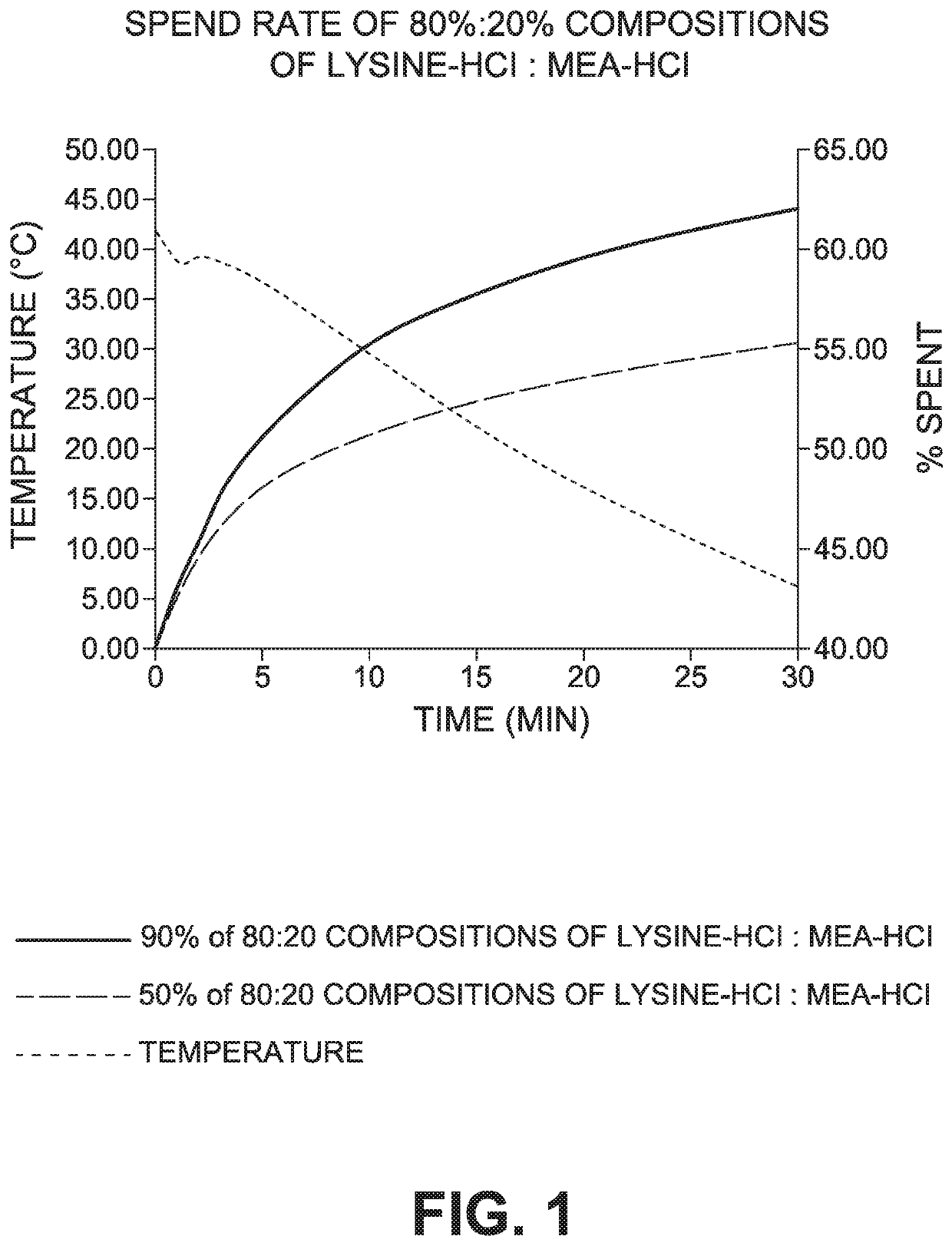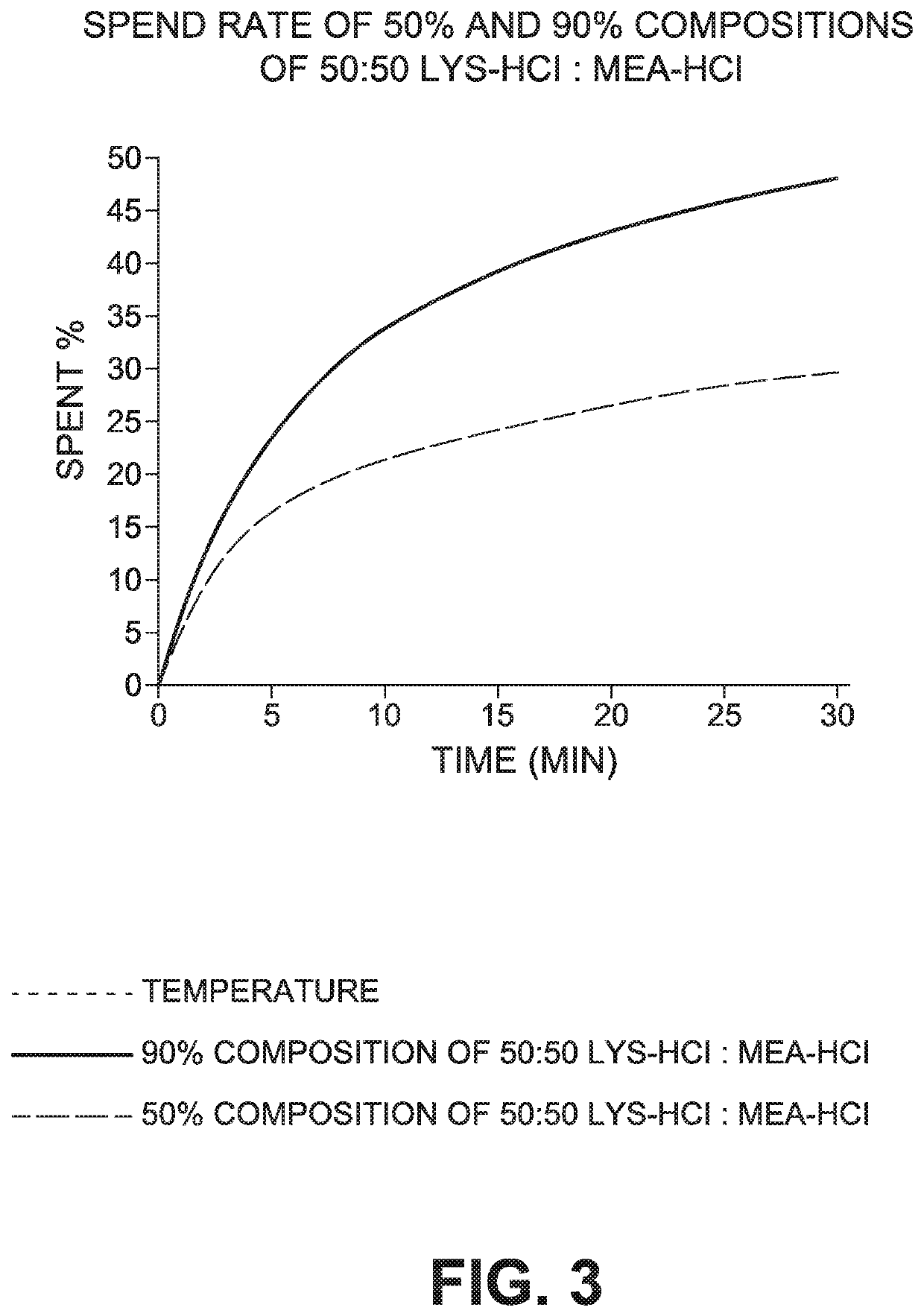Some of the major challenges faced in the oil &
gas industry from using
hydrochloric acid include the following: extremely high levels of
corrosion (which is countered by the addition of ‘filming’ type
corrosion inhibitors that are typically themselves toxic and harmful to humans, the environment and equipment) reactions between acids and various types of metals can vary greatly but softer metals, such as aluminum and
magnesium, are very susceptible to major effects causing immediate damage.
In addition, as
hydrochloric acid spends (reacts) with the formation and the pH subsequently rises after the reactions have ceased the increase in pH will cause a
precipitation of solubilized
carbonate materials causing
wellbore damage / blockage.
The inherent environmental effects (organic
sterility, poisoning of
wildlife etc.) of strong mineral acids in the event of an unintended or accidental release on surface or downhole into water aquifers or other sources of water are devastating and can cause significant
pH reduction of such and can substantially increase the
toxicity and could potentially cause a
mass culling of
aquatic species and potential poisoning of humans or
livestock and
wildlife exposed to / or drinking the water.
This is a common event at large storage sites when tanks split or leak.
Typically if near the public, large areas need to be evacuated post event and a comprehensive, expensive to implement,
emergency evacuation plan needs to be in place prior to approval of such storage areas.
The inability for mineral acids with common
corrosion and compatibility control additives and blends of such to biodegrade naturally results in expensive cleanup-reclamation costs for the operator should an unintended release occur.
Moreover, the toxic fumes produced by mineral & some organic acids are harmful to humans / animals and are highly corrosive and / or produce potentially explosive vapours.
Transportation and storage requirements for acids are restrictive and taxing.
As well, the dangers surrounding
exposure by personnel handling the blending of such dangerous products constrict their use / implementation in areas of high risk such as within city limits and environmentally sensitive areas such as offshore.
Another concern is the potential for
exposure incidents on locations due to high corrosion levels, even at ambient temperatures, of acids causing potential
storage tank structure or valve failures and / or deployment equipment failures i.e.
coiled tubing or
high pressure iron failures caused by high corrosion high rates (pitting, cracks, pinholes).
Other concerns include: downhole equipment failures from corrosion causing the operator to have to execute a work-over and replace down hole pumps, tubulars, cables, packers etc.
; inconsistent strength or
quality level of mineral & organic acids; potential supply issues based on industrial output levels; high levels of corrosion on surface pumping equipment resulting in expensive repair and maintenance levels for operators and service companies; the requirement of specialized equipment that is purpose built to pump acids greatly increasing the capital expenditures of operators and service companies; and the inability to source a finished product locally or very near its end use; transportation and onsite storage difficulties.
Typically, acids are produced in industrial areas of countries located some distance from oil & gas producing areas, up to and sometimes over 10 additives can also be required to control various aspects of the acids properties adding to complications in the handling and shipping logistics.
When used to treat scaling issues on surface equipment due to water mineral
precipitation, conventional acids are exposed to human and
mechanical devices as well as expensive equipment causing
increased risk and cost for the operator.
When mixed with bases or higher pH fluids, acids will create a large amount of
thermal energy (
exothermic reaction) causing potential safety concerns and equipment damage, acids typically need to be blended with
fresh water (due to their intolerance of highly
saline water, causing potential
precipitation of minerals) to the desired concentration requiring companies to pre-blend off-site as opposed to blending on-site with sea or
produced water thereby increasing costs associated with transportation.
Conventional mineral acids used in a
pH control application can cause rapid degradation of certain polymers and other additives requiring increased loadings or chemicals to be added to counter these negative effects.
Many offshore areas of operations have very strict regulatory rules regarding the transportation, handling and deployment of acids causing increased liability and costs for the operator.
When using an acid to pickle tubing or
pipe, very careful attention must be paid to the process due to high levels of corrosion, as temperatures increase to higher levels, the typical additives used to control corrosion in acid systems begin to degrade very quickly (due to the inhibitors “plating out” on the steel or sheering out in high
injection rate applications) causing the acids to become very corrosive and resulting in damage to downhole equipment / tubulars.
Conventional acids can be harmful to many elastomers and / or seals found in the oil & gas industry such as those found in
blow out preventers (BOP's) / downhole tools / packers / submersible pumps / seals etc.
Having to deal with
spent acid during the flow back process is also very expensive as these acids typically are still at a lower pH and remain toxic and corrosive.
Also mineral acids will typically precipitate iron and / or minerals solubilized during the operation as the pH of the
spent acid increases causing facility upsets and lost production.
Eliminating or even simply reducing the negative effects of
strong acids while maintaining their usefulness is a struggle and risk for the industry.
The careful balancing of increased safety (i.e. less fuming, less corrosive to
metal and
skin) and quick reaction time creates difficulties with operators who encounter regulatory, environmental or operational issues utilizing
hydrochloric acid.
These compositions must also be capable of being applied in operations over a wide range of temperatures while not or at least minimally affecting or corroding the equipment with which it comes in contact in comparison to a conventional
mineral acid of which the corrosion effect at ultra-high temperatures is very difficult and expensive to control.
In order to overcome these very restrictive regulations, many oil companies employ very costly containment programs for the handling of certain chemicals, such as acids, which have a wide array of uses in the industry of oil and gas exploration and production or simply forgo the use of such advantageous chemicals and thus lose substantial productivity gained by completions optimization.
Corrosion is one of the major concerns at high temperatures and is difficult and expensive to control with additional
chemistry, if it can be controlled at all.
In some situations a mechanical procedure must be utilized as opposed to a
chemical solution due to temperature constraints, such as shutting down
steam injection, running cool-down pads or slugs, or other very expensive solutions to bring the well to acceptable temperature levels.
Additionally there is the risk of
wellbore and / or formation damage due to uncontrolled solubilized mineral precipitation due to the increase in pH caused predominantly by the formation of
ammonia during the
decomposition phase.
 Login to View More
Login to View More 


